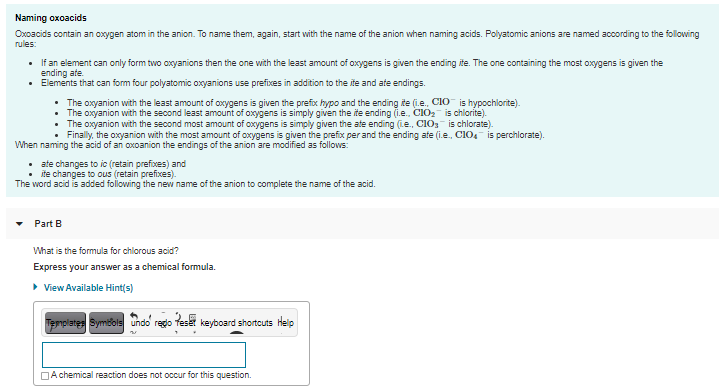Oxoacids contain an oxygen atom in the anion. To name them, again, start with the name of the anion when naming acids. Polyatomic anions are named according to the folo rules: • f an element can only form two axyanions then the one with the least amount of oxygens is given the ending ite. The one containing the most oxygens is given the ending ate. • Elements that can form four polyatomic oxyanions use prefixes in addition to the ite and ate endings. The oxyanion with the least amount of oxygens is given the prefix hypo and the ending te (i.e., CIO is hypochlorite). The oxyanion with the second least amount of oxygens is simply given the ite ending (i.e., CIÓ, is chloríte). The oxyanion with the second most amount of oxygens is simply given the ate ending (ie., CIO, is chlorate). • Finally, the oxyanion with the most amount of oxygens is given the prefix per and the ending ate (i.e., CIO, is perchlorate). When naming the acid of an oxoanion the endings of the anion are modified as follows: • ate changes to io (retain prefixes) and ite changes to ous (retain prefixes). The word acid is added following the new name of the anion to complete the name of the acid. Part B What is the formula for chlorous acid? Express your answer as a chemical formula. • View Available Hint(s) Templaten Symbols undo' redo tesbt kayboard shortcuts Help DA chemical reaction does not occur for this question.
Electron Affinity
When an element undergoes a chemical reaction, it either gains energy or loses energy. This gain or loss of energy is due to the phenomena that occur at atomic level. During reaction, atoms either gain electrons from other atoms or lose electrons to other atoms, and in that process, energy is produced.
P-Block Elements
Elements which are present on the right side of the periodic table are called p-block elements. In addition to the noble gases, they include the families of boron, mercury, nitrogen, oxygen and fluorine. These elements have diverse real-life implementations that we regularly experience around us.
Metals and Non-metals
The periodic table is composed of metals, semi-metals and nonmetal elements. The physical and chemical properties of metals and nonmetals differ from each other. The study of metals and nonmetals will help one to understand the appropriate application of the particular element.

Trending now
This is a popular solution!
Step by step
Solved in 2 steps with 1 images









